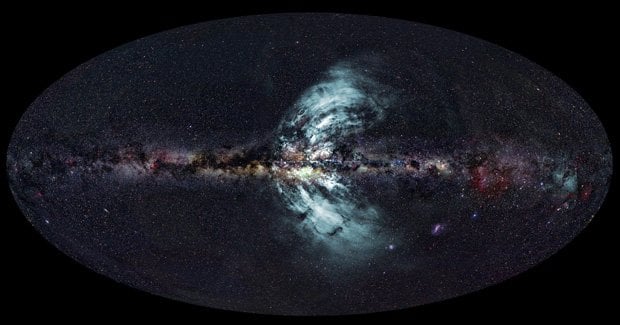‘Galactic geysers’ blasting from Milky Way

RESEARCHERS HAVE DISCOVERED and mapped two enormous energy flows streaming out at supersonic speeds from the centre of the Milky Way.
The outflows, which were detected with CSIRO’s 64m Parkes radio telescope, in NSW, are made up of hot gas and plasma, cosmic rays and magnetic fields. They are pouring from the centre of our galaxy at speeds of up to 1000km/s.
The finding, published in the journal Nature, follows the discovery of the Fermi bubbles: two giant bubbles of gas and energy that were detected by an international team of astronomers in 2010 using NASA’s Fermi gamma-ray telescope.
Bubbles in the centre of the Milky Way
The new observations have allowed researchers to confirm that the Fermi bubbles are situated at the centre of our galaxy.
In their study, the research team – made up of astronomers from Australia, the USA, Italy and the Netherlands – also revealed that both the newly detected outbursts and the Fermi bubbles are the result of the ongoing formation and death of giant stars. They are not caused by the black hole at the centre of the Milky Way.
“It’s been keenly debated as to whether the Fermi bubbles are the result of jets of material expelled by the giant black hole at the very centre of the Milky Way, or are produced by the successive explosions – like popcorn – marking the deaths of hot, short-lived stars found in our galaxy’s innermost regions,” says study coauthor, Professor Bryan Gaensler at the University of Sydney.
“Explosion after explosion of powerful stars”
“We discovered that you simply can’t explain the existence of these bubbles as due to the output of the central black hole,” Bryan told Australian Geographic. “They have to come from explosion after explosion of the powerful hot stars that are quickly born, live and die in the extreme conditions around the Milky Way’s core.”
The energy outflows extend across the galaxy for a distance of about 50,000 light-years (five hundred thousand, million, million kilometres), which is about half the length of the Milky Way’s diameter. Seen from Earth, they stretch across about two-thirds of sky from horizon to horizon.
“These outflows contain an extraordinary amount of energy…about a million times the energy of an exploding star,” says lead researcher and CSIRO scientist Dr Ettore Carretti.
Professor Lister Staveley-Smith, study co-author from the University of Western Australia, says that by understanding outflows – and learning more about their energy inputs from hot gas, supernovae, radiation, stellar winds and black holes – astronomers will be better equipped to determine how galaxies evolve.
Cosmology and the formation of galaxies
“It is vital that we better understand the physical process and energy available for these feedback and outflow events,” he says. “Doing so will allow us to better understand cosmology and the formation of all galaxies, not just our own Milky Way.”
Bryan agrees that by determining the energy source fuelling the Fermi bubbles and the newly discovered outbursts, scientists are better able to forecast the future of the universe.
“We now have a consistent picture of our own home galaxy caught in the act of belching its material into intergalactic space,” he says, adding that what we can see crudely in distant galaxies, we can now study in detail at home. “We also now have a clear measurement of just what is driving this galactic indigestion – it’s the combined effect of the titanic explosions of the largest stars in the galaxy.”
“Results like this allow us to accurately calibrate the mechanism and rate through which galaxies discard their raw materials, helping us forecast the universe’s inevitable decline into senescence,” he says.
RELATED STORIES

